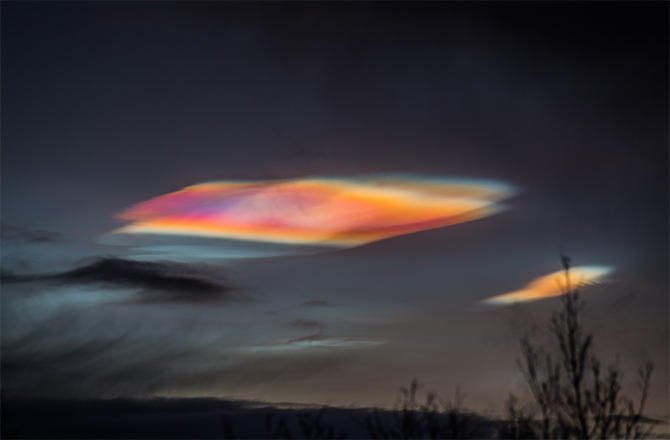Dangerous nacreous clouds in the polar region
The dark black sky of the polar region in winter is not only the backdrop for the northern aurora bands, but also the presence of an equally natural phenomenon named nacre cloud.

Nacreous clouds over Norway sky.(Photo: Truls Melbye Tiller).
According to IFL Science, nacre clouds formed in the polar stratosphere in winter, at an altitude of 15,000 - 25,000m. Because nacre clouds are higher than normal clouds, the surrounding air is very cold, usually down to -85 ° C.
Nacreous clouds are made up of small particles that freeze and position high to allow them to receive sunlight. Touching the particles, light is refracted, divided into colorful bands, as in photos taken on December 16 by photographer Truls Melbye Tiller in Tromsø, Norway.
However, these clouds contribute significantly to the destruction of the ozone layer. They provide a surface that removes gaseous nitric acid, disturbs the nitrogen cycle, and assists the reaction to produce activated chlorine, the catalyst that leads to the ozone layer gap.
What is nacre cloud?
Nacreous cloud or polar stratospheric cloud (abbreviated: PSC) is a polar stratospheric cloud in the winter, at an altitude of about 15,000-25,000 meters (50,000–80,000 ft). It is closely related to the formation of ozone holes; Their effects on ozone depletion arise because they support chemical reactions that produce activated chlorine, which catalyzes the destruction of ozone, as well as because they remove gas nitric acid, making disturbing nitrogen and chlorine cycles toward destruction of ozone.
- Rare blue clouds in the polar region
- Terrifying foreboding of strange clouds
- Formation of strange clouds on Antarctica
- Cloud glowing strange in the night
- Why do airlines not fly over the polar regions?
- French people stunned because of rotten clouds
- Video: Aurora and noctilucent clouds appear at the same time
- Watch the clouds with strange shapes
- Very strange, poisonous scales
- Track polar bears from space
- Polar regions appear mysterious glowing clouds
- Only watching flying clouds can predict the danger of weather
 Is the magnetic North Pole shift dangerous to humanity?
Is the magnetic North Pole shift dangerous to humanity? Washington legalizes the recycling of human bodies into fertilizer
Washington legalizes the recycling of human bodies into fertilizer Lightning stone - the mysterious guest
Lightning stone - the mysterious guest Stunned by the mysterious sunset, strange appearance
Stunned by the mysterious sunset, strange appearance